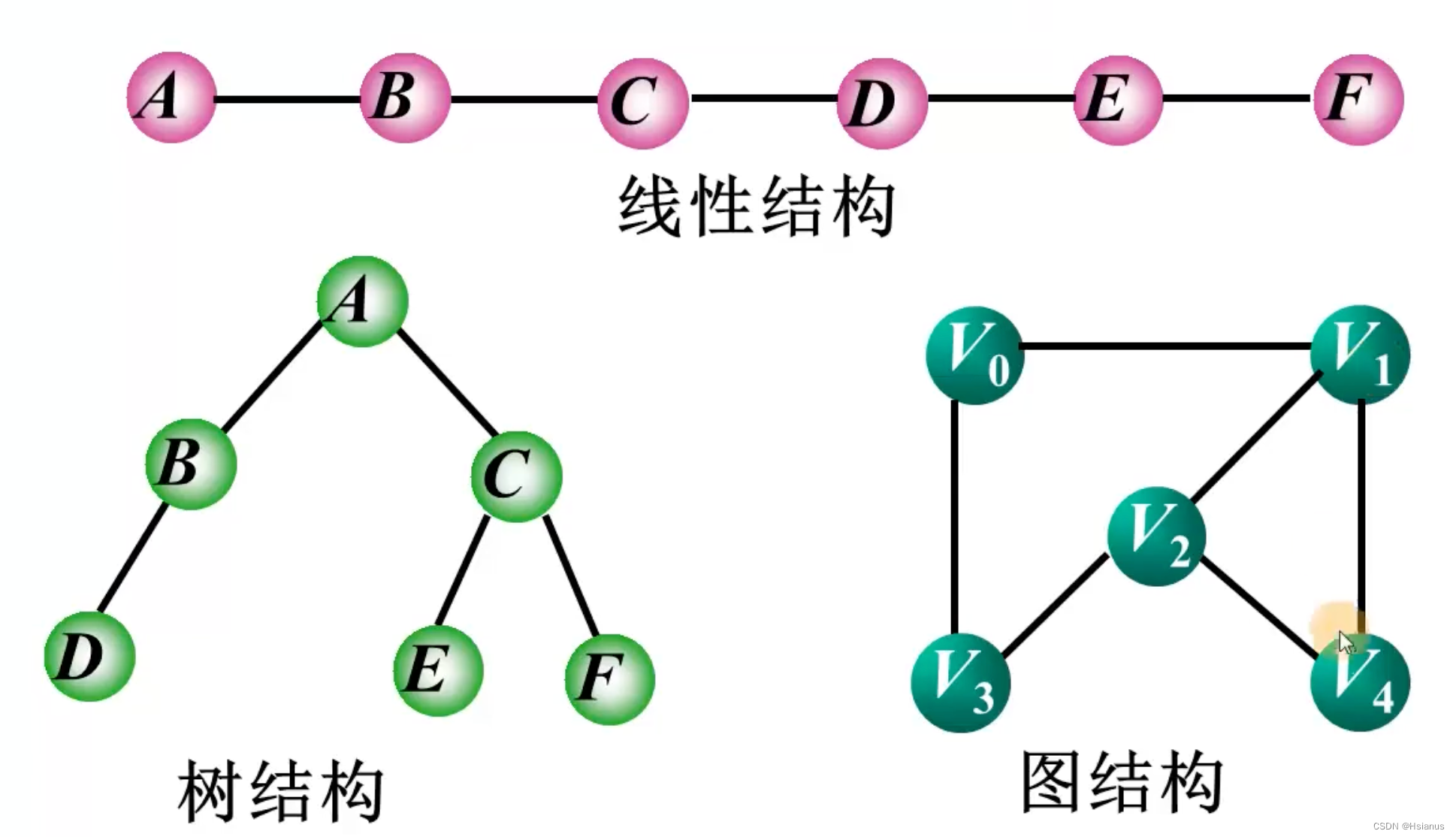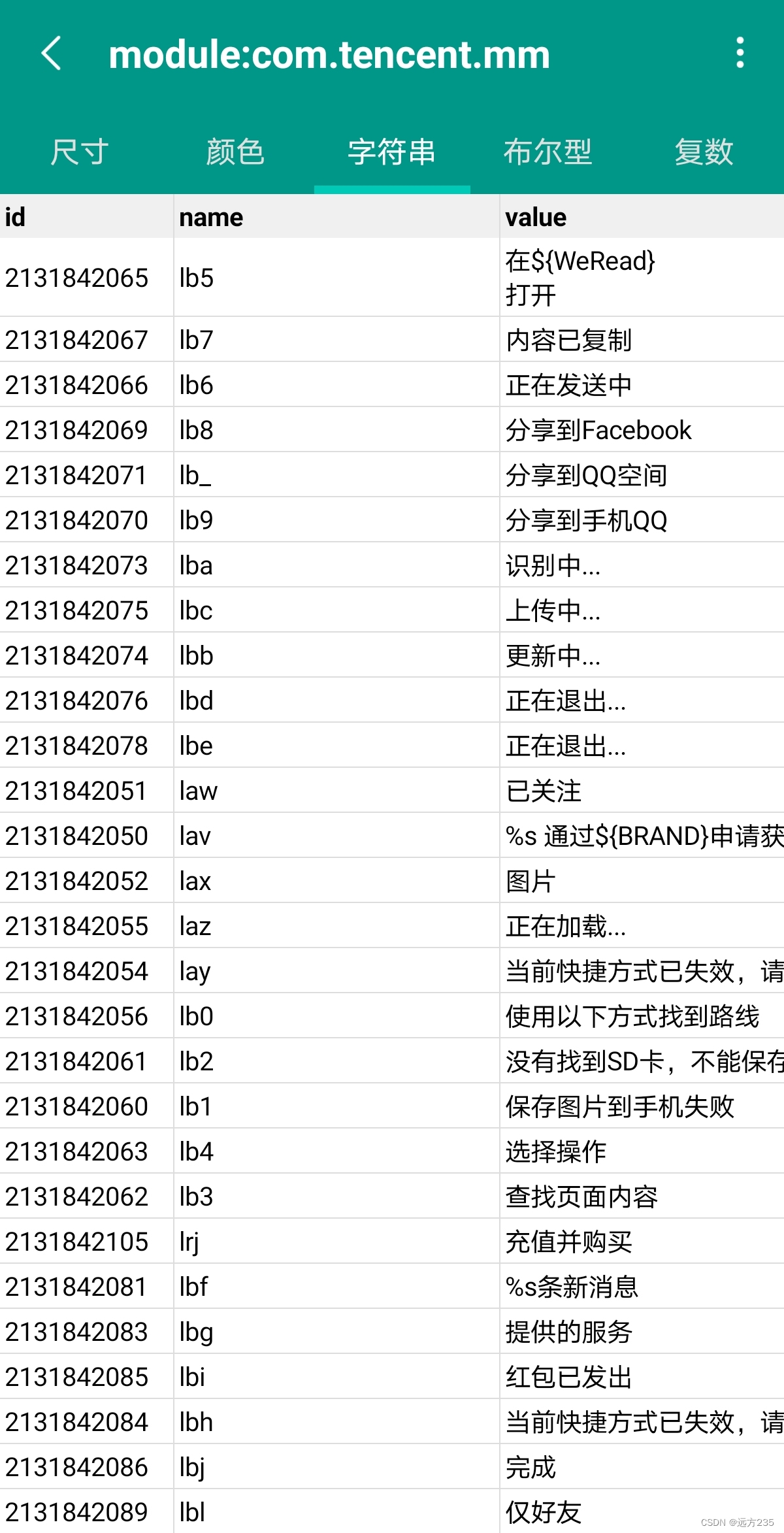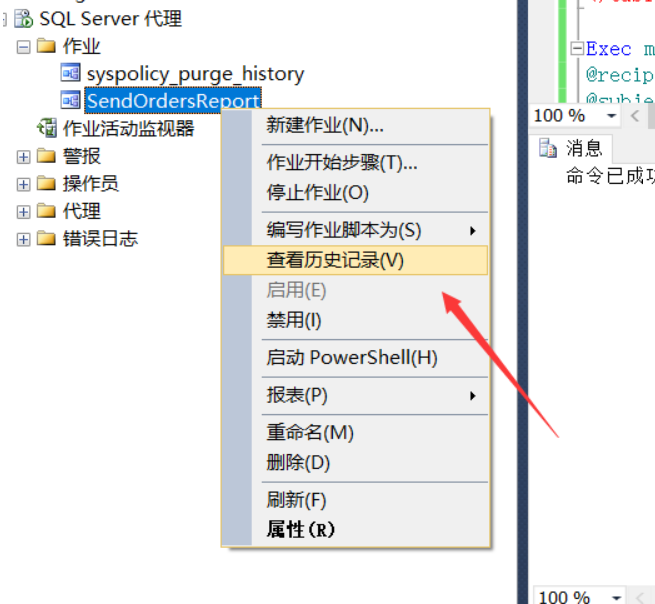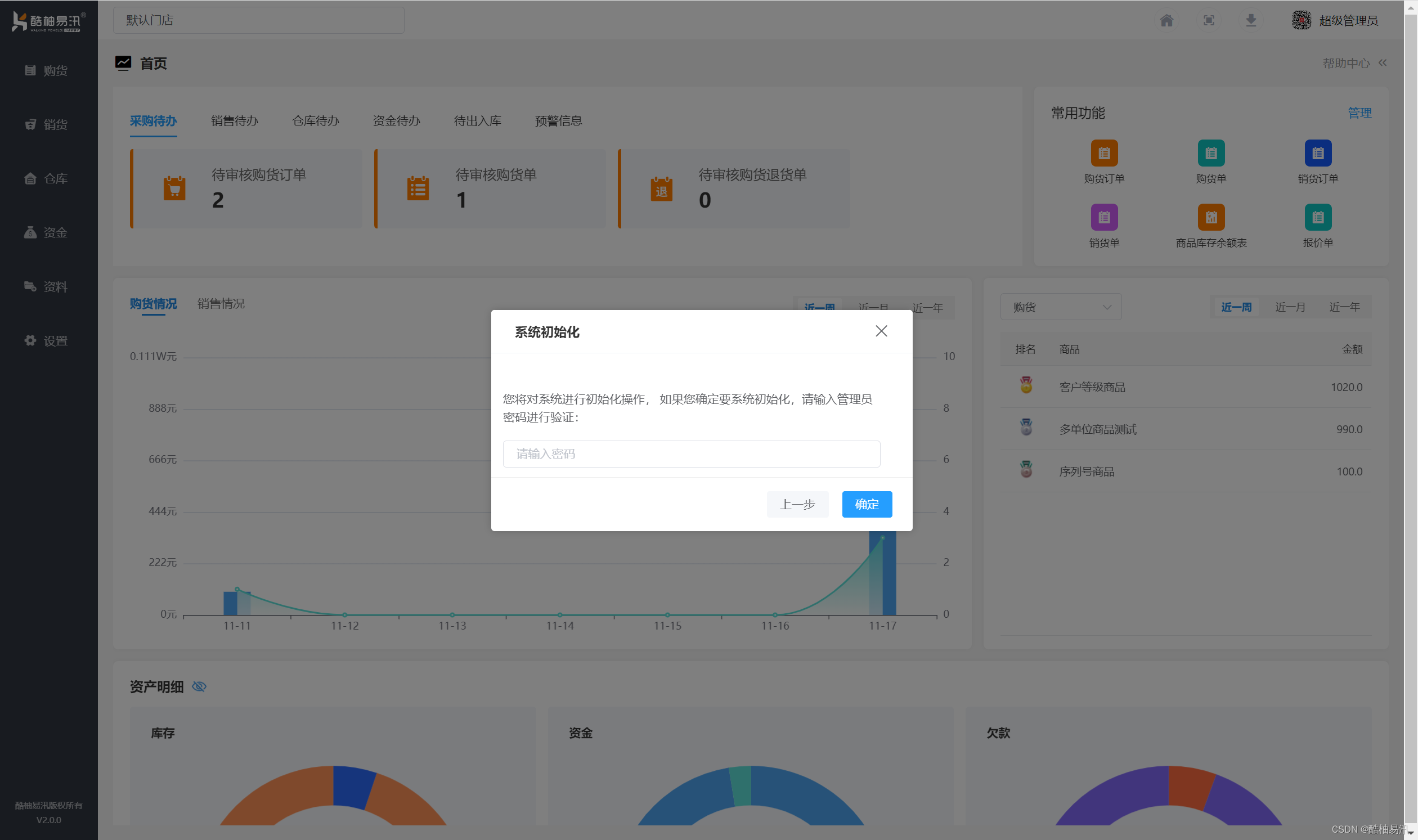Flume 概述
Flume 是 Cloudera 提供的一个高可用的,高可靠的,分布式的海量日志采集、聚合和传输的系统
Flume 基于流式架构,灵活简单
Flume最主要的作用就是,实时读取服务器本地磁盘的数据,将数据写入到HDFS
基础架构
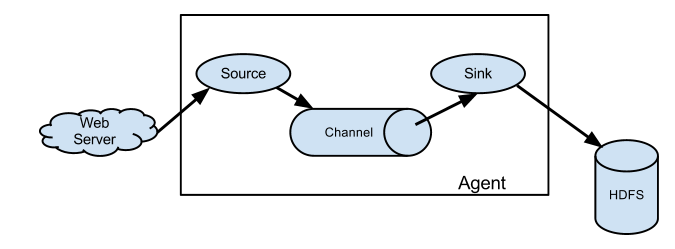
Agent
Agent 是一个 JVM 进程,它以事件的形式将数据从源头送至目的
Agent 主要有 3 个部分组成,Source、Channel、Sink
Source
Source 是负责接收数据到 Flume Agent 的组件。Source 组件可以处理各种类型、各种格式的日志数据,包括 avro、thrift、exec、jms、spooling directory、netcat、taildir、sequence generator、syslog、http、legacy
Sink
Sink 不断地轮询 Channel 中的事件且批量地移除它们,并将这些事件批量写入到存储或索引系统、或者被发送到另一个 Flume Agent
Sink 组件目的地包括 hdfs、logger、avro、thrift、ipc、file、HBase、solr、自定义
Channel
Channel 是位于 Source 和 Sink 之间的缓冲区。因此,Channel 允许 Source 和 Sink 运作在不同的速率上Channel 是线程安全的,可以同时处理几个 Source 的写入操作和几个Sink 的读取操作
Flume 自带两种 Channel:Memory Channel 和 File Channel
- Memory Channel 是内存中的队列。Memory Channel 在不需要关心数据丢失的情景下适用。如果需要关心数据丢失,那么 Memory Channel 就不应该使用,因为程序死亡、机器宕机或者重启都会导致数据丢失。
- File Channel 将所有事件写到磁盘。因此在程序关闭或机器宕机的情况下不会丢失数据
Event
Flume 数据传输的基本单元,以 Event 的形式将数据从源头送至目的地
Event 由 Header 和 Body 两部分组成,Header 用来存放该 event 的一些属性,为 K-V 结构,Body 用来存放该条数据,形式为字节数组
Flume 安装部署
flume官网:Welcome to Apache Flume — Apache Flume
官方文档:Flume 1.11.0 User Guide — Apache Flume
下载:Index of /dist/flume
1.下载tar包:

版本:1.9.0
2.上传到服务器,解压至/opt/module/路径下;
3.重命名:mv /opt/module/apache-flume-1.9.0-bin/opt/module/flume
4.将 lib 文件夹下的 guava-11.0.2.jar 删除以兼容 Hadoop 3.1.3:rm/opt/module/flume/lib/guava-11.0.2.jar
Flume入门案例
监控端口数据官方案例
需求:使用 Flume 监听一个端口,收集该端口数据,并打印到控制台
实现步骤:
- 通过netcat工具向本机的44444端口发送数据
- Flume监控本机的44444端口,通过Flume的source端读取数据
- Flume将获取的数据通过Sink端写出到控制台
实现流程:
- 安装 netcat 工具:
sudo yum install -y nc - 判断 44444 端口是否被占用:
netstat -nlp | grep 44444
netstat:显示网络状态;
相关参数说明:Linux netstat命令 | 菜鸟教程
- 在 flume 目录下创建 job 文件夹并进入 job 文件夹;
- 在 job 文件夹下创建 Flume Agent 配置文件
net-flume-logger.conf - 配置文件内容如下:
# example.conf: A single-node Flume configuration
# Name the components on this agent(source,channel,sink的名称)
a1.sources = r1
a1.sinks = k1
a1.channels = c1
# Describe/configure the source(source的类型,绑定的ip)
a1.sources.r1.type = netcat
a1.sources.r1.bind = localhost
a1.sources.r1.port = 44444
# Describe the sink(sink的类型)
a1.sinks.k1.type = logger
# Use a channel which buffers events in memory(channel的类型,容量)
a1.channels.c1.type = memory
a1.channels.c1.capacity = 1000
a1.channels.c1.transactionCapacity = 100
# Bind the source and sink to the channel(将source、sink和channel绑定)
a1.sources.r1.channels = c1
a1.sinks.k1.channel = c1具体参数详解如下:
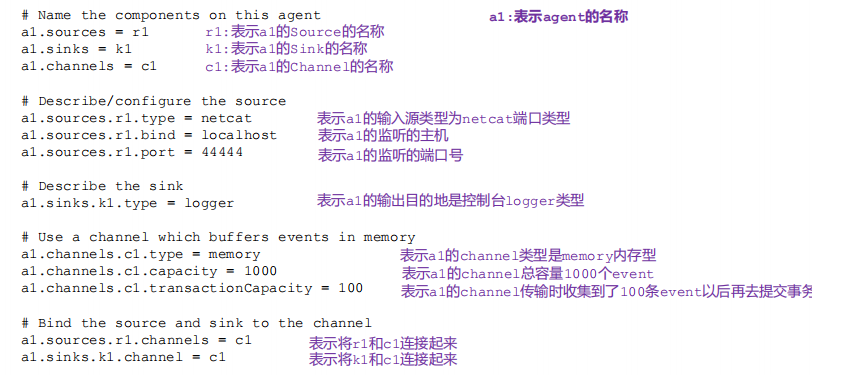
- 开启 flume 监听端口:
bin/flume-ng agent --conf conf/ --name a1 --conf-file job/net-flume-logger.conf -Dflume.root.logger=INFO,console或者bin/flume-ng agent -c conf/ -n a1 -f job/net-flume-logger.conf -Dflume.root.logger=INFO,console
参数说明:
--conf/-c:表示配置文件存储在 conf/目录
--name/-n:表示给 agent 起名为 a1
--conf-file/-f:flume 本次启动读取的配置文件是在 job 文件夹下的 flume-telnet.conf文件
-Dflume.root.logger=INFO,console :-D 表示 flume 运行时动态修改 flume.root.logger参数属性值,并将控制台日志打印级别设置为 INFO 级别。日志级别包括:log、info、warn、error
- 使用 netcat 工具向本机的 44444 端口发送内容:
nc localhost 44444
![]()
- 在 Flume 监听页面观察接收数据情况:

实时监控单个追加文件
需求:实时监控 Hive 日志,并上传到 HDFS 中
实现流程:
1.flume要想将数据上传到hadoop,需要依赖相关的jar包,所以需要确定hadoop及Java的环境变量已经配置好了:

2.创建配置文件(在job目录下):flume-file-hdfs.conf
# Name the components on this agent
a2.sources = r2
a2.sinks = k2
a2.channels = c2
# Describe/configure the source
a2.sources.r2.type = exec
a2.sources.r2.command = tail -F /opt/module/hive/logs/hive.log
# Describe the sink
a2.sinks.k2.type = hdfs
a2.sinks.k2.hdfs.path = hdfs://hadoop102:9820/flume/%Y%m%d/%H
#上传文件的前缀
a2.sinks.k2.hdfs.filePrefix = logs-
#是否按照时间滚动文件夹
a2.sinks.k2.hdfs.round = true
#多少时间单位创建一个新的文件夹
a2.sinks.k2.hdfs.roundValue = 1
#重新定义时间单位
a2.sinks.k2.hdfs.roundUnit = hour
#是否使用本地时间戳
a2.sinks.k2.hdfs.useLocalTimeStamp = true
#积攒多少个 Event 才 flush 到 HDFS 一次
a2.sinks.k2.hdfs.batchSize = 100
#设置文件类型,可支持压缩
a2.sinks.k2.hdfs.fileType = DataStream
#多久生成一个新的文件
a2.sinks.k2.hdfs.rollInterval = 60
#设置每个文件的滚动大小
a2.sinks.k2.hdfs.rollSize = 134217700
#文件的滚动与 Event 数量无关
a2.sinks.k2.hdfs.rollCount = 0
# Use a channel which buffers events in memory
a2.channels.c2.type = memory
a2.channels.c2.capacity = 1000
a2.channels.c2.transactionCapacity = 100
# Bind the source and sink to the channel
a2.sources.r2.channels = c2
a2.sinks.k2.channel = c2参数说明:
①source为exec source:Flume 1.11.0 User Guide — Apache Flume
- exec及execute的意思,执行给定的Uxin系统指令;
- 相应的command即需要执行的指令,在本示例中即读取Hive日志文件中的内容
tail -F:循环读取Linux tail 命令 | 菜鸟教程
②sind为hdfs sinkFlume 1.11.0 User Guide — Apache Flume
path即hdfs上文件的路径,hdfs sink允许使用一些转义序列,如下:

根据官网描述:
The files can be rolled (close current file and create a new one) periodically based on the elapsed time or size of data or number of events
文件的滚动可以通过时间、文件、events的数量来控制;
- 时间:主要是
round——是否开启时间控制;roundUnit——时间单位;roundValue——时间值

- 文件:主要是
rollInterval——生成新文件的间隔(设置为0表示不按照时间滚动);rollSize——单个文件的最大大小(单位:bytes);rollCount——新文件生成时必须满足的events数量;

- events数量:通过
batchSize来设置
![]()
③对于所有与时间相关的转义序列,Event Header 中必须存在以 “timestamp”的key(除非 hdfs.useLocalTimeStamp 设置为 true,此方法会使用 TimestampInterceptor 自动添加 timestamp)

3.执行指令:bin/flume-ng agent --conf conf/ --name a2 --conf-file job/flume-file-hdfs.conf
4.执行hive指令,生成日志文件;为了简单测试这里直接向hive.log文件中写内容:
echo "test.2023.11.17" > hive.log到hdfs中去查看,可以看到对应的文件:

实时监控目录下多个新文件
需求:使用 Flume 监听整个目录的文件,并上传至 HDFS
实现流程:
1.创建配置文件 flume-dir-hdfs.conf
配置文件内容如下:
a3.sources = r3
a3.sinks = k3
a3.channels = c3
# Describe/configure the source
a3.sources.r3.type = spooldir
#定义监控目录
a3.sources.r3.spoolDir = /opt/module/flume/upload
a3.sources.r3.fileSuffix = .COMPLETED
a3.sources.r3.fileHeader = true
#忽略所有以.tmp 结尾的文件,不上传
a3.sources.r3.ignorePattern = ([^ ]*\.tmp)
# Describe the sink
a3.sinks.k3.type = hdfs
a3.sinks.k3.hdfs.path = hdfs://hadoop102:8020/flume/upload/%Y%m%d/%H
#上传文件的前缀
a3.sinks.k3.hdfs.filePrefix = upload-
#是否按照时间滚动文件夹
a3.sinks.k3.hdfs.round = true
#多少时间单位创建一个新的文件夹
a3.sinks.k3.hdfs.roundValue = 1
#重新定义时间单位
a3.sinks.k3.hdfs.roundUnit = hour
#是否使用本地时间戳
a3.sinks.k3.hdfs.useLocalTimeStamp = true
#积攒多少个 Event 才 flush 到 HDFS 一次
a3.sinks.k3.hdfs.batchSize = 100
#设置文件类型,可支持压缩
a3.sinks.k3.hdfs.fileType = DataStream
#多久生成一个新的文件
a3.sinks.k3.hdfs.rollInterval = 60
#设置每个文件的滚动大小大概是 128M
a3.sinks.k3.hdfs.rollSize = 134217700
#文件的滚动与 Event 数量无关
a3.sinks.k3.hdfs.rollCount = 0
# Use a channel which buffers events in memory
a3.channels.c3.type = memory
a3.channels.c3.capacity = 1000
a3.channels.c3.transactionCapacity = 100
# Bind the source and sink to the channel
a3.sources.r3.channels = c3
a3.sinks.k3.channel = c3参数说明:
source类型是spooldir:Flume 1.11.0 User Guide — Apache Flume
根据官网的描述:This source will watch the specified directory for new files, and will parse events out of new files as they appear
该类型的source会监控特定目录,当目录下出现新文件的时候,会进行文件的上传
- spoolDir:文件监控的目录
- fileSuffix:默认值
.COMPLETED,文件后缀 - fileHeader:是否添加文件头
- ignorePattern:定义忽略的文件;
ignorePattern = ([^ ]*\.tmp):忽略所有以tmp结尾的文件而不上传
2.启动指令: bin/flume-ng agent --conf conf/ --name a3 --conf-file job/flume-dir-hdfs.conf
3.在/opt/module/flume/upload文件夹中上传文件:
touch why.txt
touch why.tmp
touch why.log可以看到添加了文件后缀:
![]()
hdfs中也有了对应的文件:

实时监控目录下的多个追加文件(断点续传)
- Exec source 适用于监控一个实时追加的文件,不能实现断点续传
- Spooldir Source适合用于同步新文件,但不适合对实时追加日志的文件进行监听并同步
- Taildir Source适合用于监听多个实时追加的文件,并且能够实现断点续传
需求:使用 Flume 监听整个目录的实时追加文件(向文件中写入新的内容),并上传至 HDFS
实现流程:
1.创建配置文件 flume-taildir-hdfs.conf
文件内容如下:
a3.sources = r3
a3.sinks = k3
a3.channels = c3
# Describe/configure the source
a3.sources.r3.type = TAILDIR
a3.sources.r3.positionFile = /opt/module/flume/tail_dir.json
a3.sources.r3.filegroups = f1 f2
a3.sources.r3.filegroups.f1 = /opt/module/flume/files/.*txt.*
a3.sources.r3.filegroups.f2 = /opt/module/flume/files2/.*log.*
# Describe the sink
a3.sinks.k3.type = hdfs
a3.sinks.k3.hdfs.path = hdfs://hadoop102:8020/flume/upload2/%Y%m%d/%H
#上传文件的前缀
a3.sinks.k3.hdfs.filePrefix = upload-
#是否按照时间滚动文件夹
a3.sinks.k3.hdfs.round = true
#多少时间单位创建一个新的文件夹
a3.sinks.k3.hdfs.roundValue = 1
#重新定义时间单位
a3.sinks.k3.hdfs.roundUnit = hour
#是否使用本地时间戳
a3.sinks.k3.hdfs.useLocalTimeStamp = true
#积攒多少个 Event 才 flush 到 HDFS 一次
a3.sinks.k3.hdfs.batchSize = 100
#设置文件类型,可支持压缩
a3.sinks.k3.hdfs.fileType = DataStream
#多久生成一个新的文件
a3.sinks.k3.hdfs.rollInterval = 60
#设置每个文件的滚动大小大概是 128M
a3.sinks.k3.hdfs.rollSize = 134217700
#文件的滚动与 Event 数量无关
a3.sinks.k3.hdfs.rollCount = 0
# Use a channel which buffers events in memory
a3.channels.c3.type = memory
a3.channels.c3.capacity = 1000
a3.channels.c3.transactionCapacity = 100
# Bind the source and sink to the channel
a3.sources.r3.channels = c3
a3.sinks.k3.channel = c3参数说明:
source类型为taildir:Flume 1.11.0 User Guide — Apache Flume
- positionFile:默认值:
~/.flume/taildir_position.json;根据官方的解释,该文件是用于记录inode的值的,inode即linux中储存文件元数据的区域,linux中可以通过inode来识别不同的文件,因此taildir source通过维护positionFile即可记录每个文件读取到的最新的位置,从而实现断点续传; - filegroups & filegroups.<filegroupName>:定义一个或多个需要监控的目录;
.*txt.*即表示所有以txt结尾的文件
3.执行指令: bin/flume-ng agent --conf conf/ --name a3 --conf-file job/flume-taildir-hdfs.conf
4.向/opt/module/flume/files目录下的文件中写入内容:
echo hello1 >> file1.txt
echo hello2 >> file2.txt
echo hello3 >> file3.txt
echo hello4 >> file4.txt在files2中:
echo log1 >> log1.loghdfs中出现相应的文件:

内容如下:

继续在files中执行:echo log2 >> log1.log
可以看到已经同步更新:



